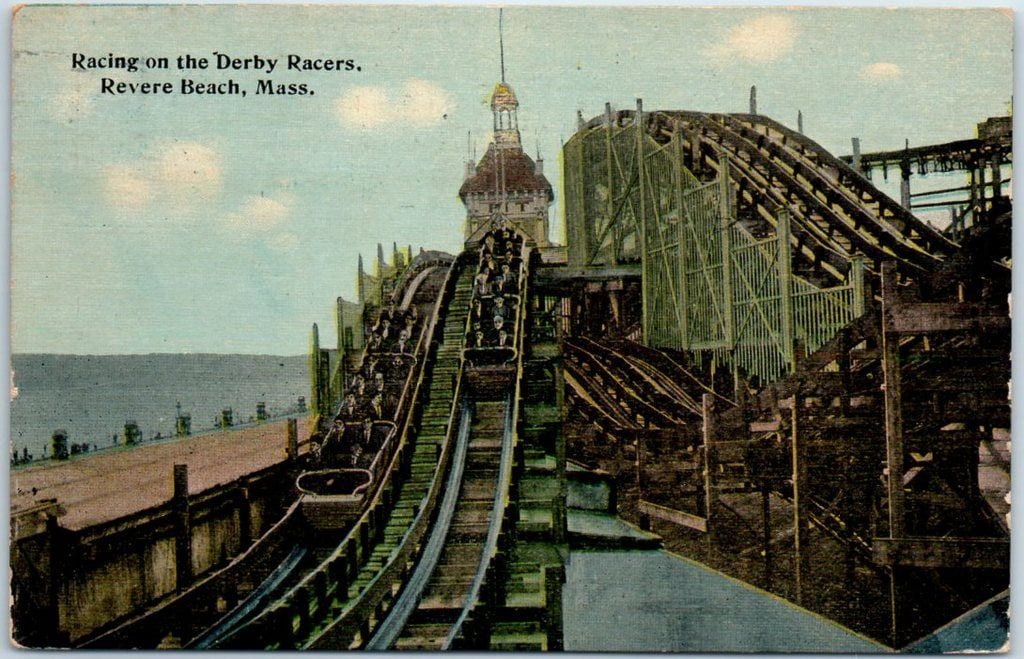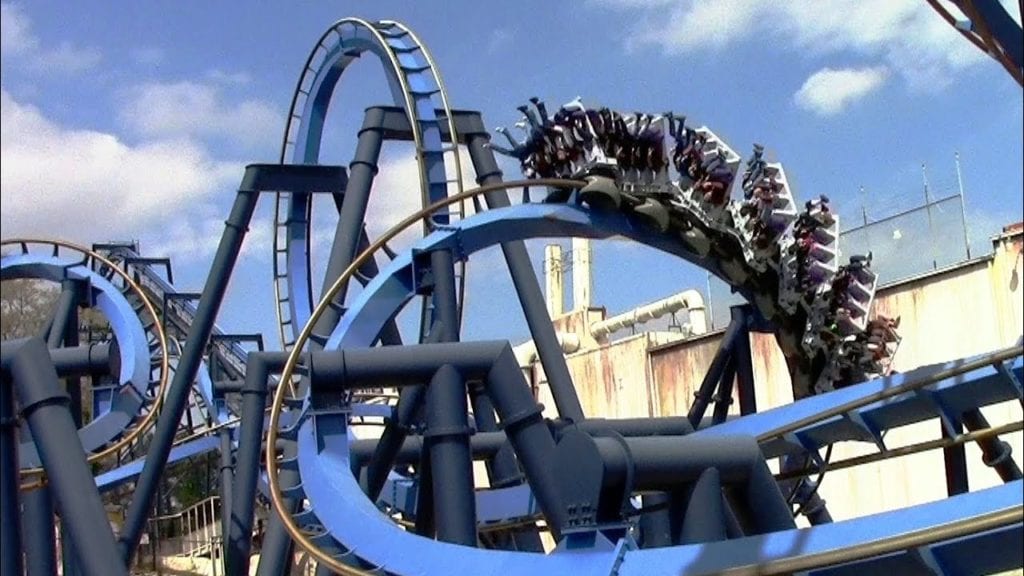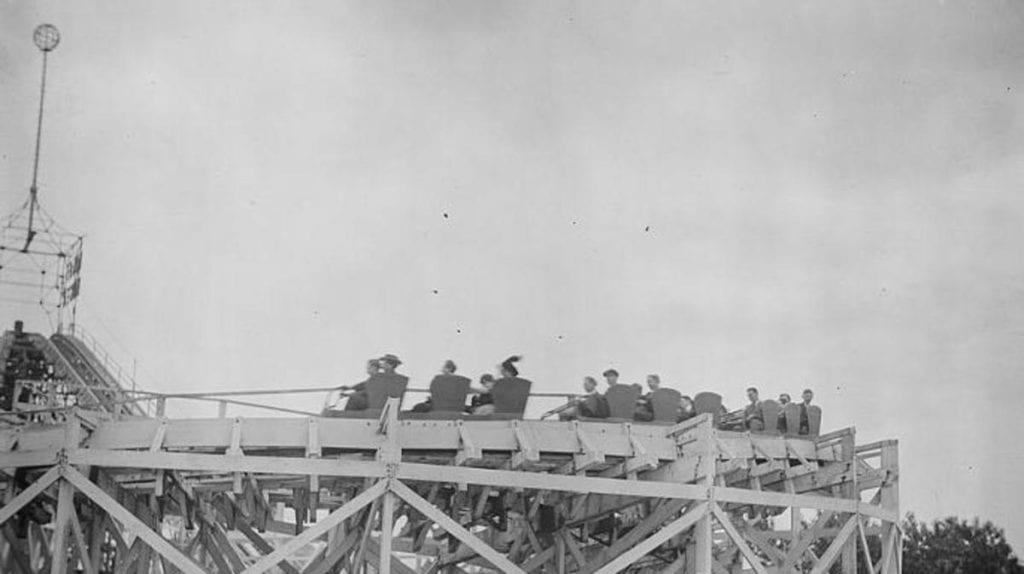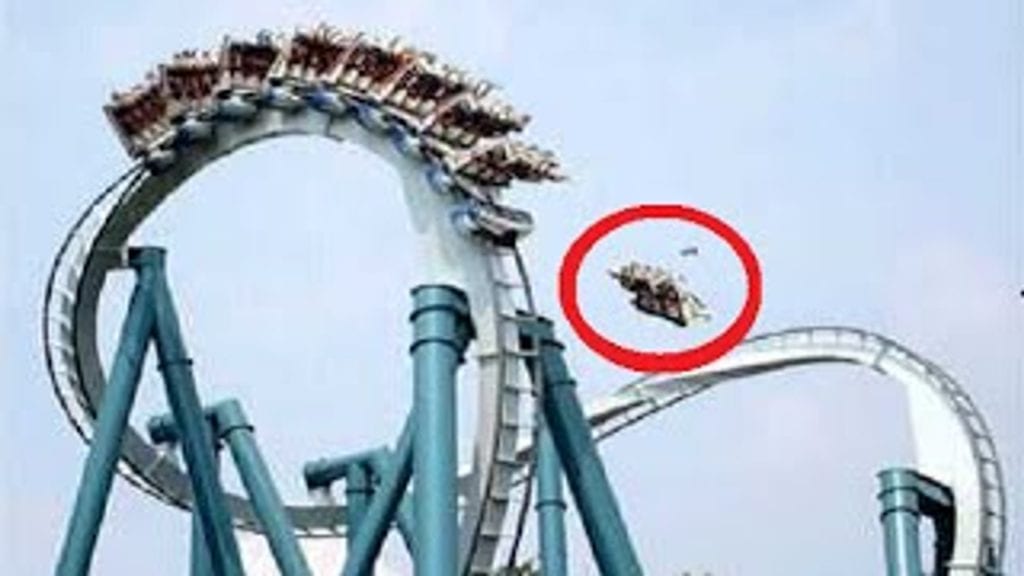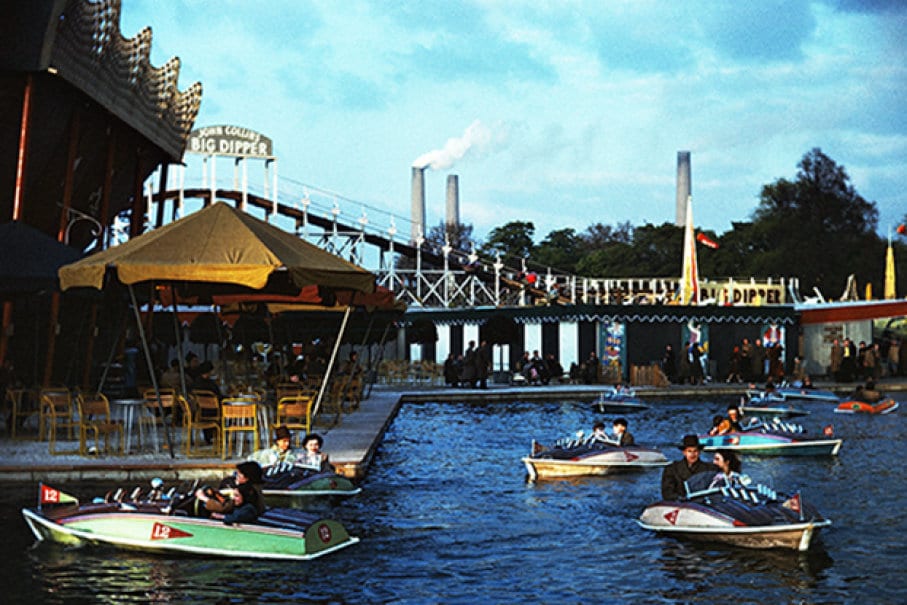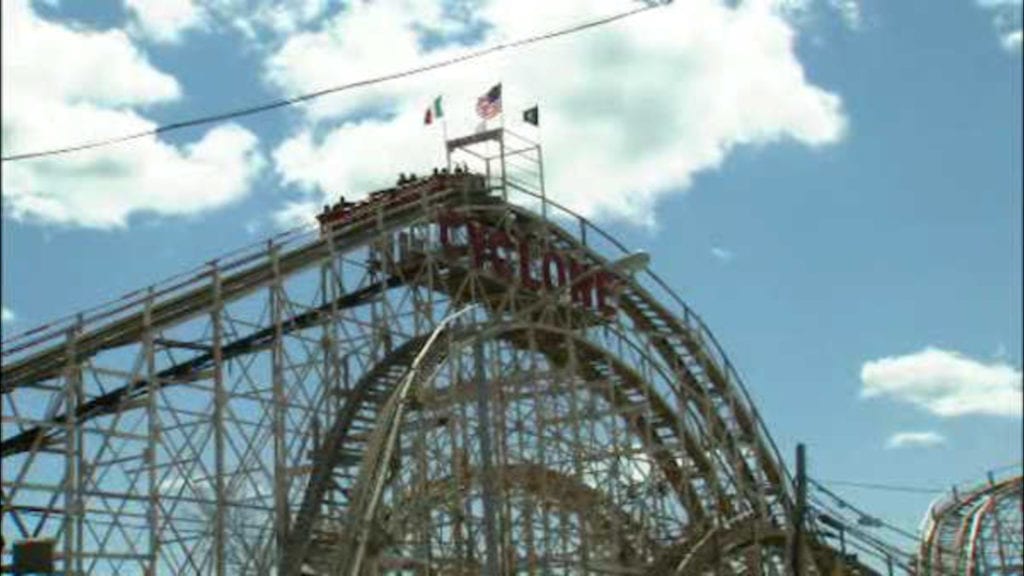10 Derby Racer, Revere Beach, Massachusetts
The Derby Racer has a spotted history, beginning right when it opened in 1910. The owner of the Revere Beach theme park at the time stood up to present a lecture on amusement park safety, and in a bout of sheer irony, he fell from the one of the coaster’s cars and was killed instantly. In 1917, another fatality occurred when a passenger lost his hat on the coaster’s initial incline, and in trying to retrieve it, he fell onto the opposing track, was hit by the other car, and then dragged a total of 35 feet. The Boston Daily Globe reported that the man had broken every bone in his body, and he died later in hospital. While the coaster was finally demolished in 1919, this wasn’t before another fatality occurred; a third rider was thrown from the train, and her family filed a Supreme Court suit in 1936 against Ocean View Amusements, who ran the coaster at the time. The coaster was replacing soon after its demolition with another bearing the same name, but the negative association proved to harm sales, and it was also demolished 10 years later.
9 Mission: Space, Disney World, Florida
Mission Space is controversial for being one of the most intense space-flight simulators accessible to the public, being connected to a centrifuge similar to that used by NASA trainees. Passengers are spun, being subject to 2.5Gs of force, twice that of gravity, in what is meant to achieve similar weightlessness to that which astronauts experience. Between the summers of 2005 and 2006, park employees had to manage 200 injuries caused by the ride, including incidents of people passing out, suffering chest pain or even suffering from irregular heartbeats. Two people also died during that period, the first being a five-year old boy who suffered from heart failure in 2005 that was brought on by a prior heart condition. The other death took place in 2006, only ten months later, when a 49-year old woman complained of nausea and dizziness, symptoms common to prior riders. Disney park employees examined her afterwards and believed she was stable, yet upon admission to hospital, she passed away of a brain hemorrhage. Since then, Disney has stepped up to determine how to balance their intent for the ride with its potential to be too intense. The ride currently operates under two levels; “Green Team”, and “Orange Team”, the former of which providing many of the same effects as the original ride, yet done so with much less force and pressure, and therefore fewer physical side-effects. “Orange Team” is the classic ride, and it pushes the culpability to the rider for what they feel they can handle.
8 Batman: The Ride, Six Flags Over Georgia, Georgia
This coaster itself is not for the faint of heart, reaching speeds of 80km/h and twisting riders through harrowing inverted loops and turns, and boasting an 105-foot drop. However, the inverted concept of the ride proved deadly in the spring of 2002, when a 58-year old employee was stuck in the head by the dangling leg of a 14-year old rider and later died in hospital. The girl was also taken to hospital afterwards, yet she sustained only mild injuries. The second fatality in the ride’s history, and arguably the most catastrophic, occurred when a teenager visiting with his youth group entered the restricted area of the ride, having to scale two fences to get there. It was said that he was trying to retrieve his hat, which had fallen off. He was struck by one of the cars going full speed and was decapitated. No one in the cars, however, were injured.
7 Rough Riders, Coney Island, New York
The name Rough Riders was what initially drew attention to this ride, being the name that President Theodore Roosevelt used for his cavalry regiment. It opened in 1915, and differed from modern coasters in that each car had a ride-on driver, akin to what one might find in a modern subway train. Everything was going smoothly until the car abruptly accelerated, causing its wheels to leave the track as the whole car flipped and turned on its side. Ahead, 30 feet off the ground, was an iron railing which the passengers were then flung into. Three people died from falling from that height, and the lone two survivors were a mother and her 4-year old son, who were able to cling to the wrecked car’s handrail. One bystander was also killed by the body of the driver falling and hitting her from above, bringing the death toll to four. The park was found not responsible for the accident, with jurors later determining that the accident was “unavoidable”.
6Verrückt Waterslide, Schlitterbahn, Kansas City
Effectively earning its name (which is German for “crazy”), Verruckt opened in July 2014, being the tallest waterslide in the world at the time, with a height of 168 feet 7 inches. Upon its initial testing there were concerns surrounding the ride’s safety, with rafts being flung into the air and reaching speeds of 70km/hr. Nonetheless, it opened to the public. In the year following its grand opening, at least thirteen riders complained of injuries from being thrown into the netting, receiving concussions or slipped and herniated discs. The park’s manager was known to have attempted to cover these up, especially in a 2016 case where a man slipped and fell from the raft, sustaining facial injuries. The ride met its demise when Caleb Schwab, the 10-year old son of the state legislator, was killed while on the slide. After the initial descent, the force of the slide caused his raft to go airborne, and he slammed into a metal pole in the netting and was decapitated. It was determined that the cause of this was the fact that he had been permitted to sit at the front of the ride, despite two women who were heavier than him being on the raft at the same time. The three of their combined weight was greater than the ride’s max capacity, stressing the raft. The women sustained non-fatal injuries, with one receiving a broken jaw, and the other getting stitches due to receiving facial fractures. Given the position of Schwab’s father, the case was brought to court and the park was shut down temporarily while the proceedings ensued. The director of operations was found guilty of aggravated battery, aggravated child endangerment, involuntary manslaughter, and interference with law enforcement. It was found that despite numerous warnings about the risks posed by the ride, it was allowed to run, nonetheless. The park’s operators were acquitted on the basis of inadmissible evidence, but the ride was shut down later in 2018.
5 Fujin Raijin II, Expoland, Suita, Japan
Disaster struck on May 5th, 2007, conveniently being the same date that Children’s Day is celebrated in Japan. The seated coaster had operated for 15 years beforehand with no issues, being one of the most popular attractions at Expoland. The coaster was unique in that it was designed for riders to remain standing, and reached a top speed of 75km/h. The ride was almost over when one of the wheel axels on the car broke, causing it to lurch to the side and a woman to die due to smashing her head into the guardrail. The coaster dragged her for 300 meters before finally coming to a stop, and eighteen other riders sustained non-life-threatening injuries. It turned out that the axel that broke hadn’t been checked or repaired in 15 years and was found on the ground below afterward. Three employees attempted to cover this fact up and ended up being found guilty of professional negligence resulting in death and injury, as well as for falsifying claims that the park conducted regular checks on the roller coaster. Their defense was that the park didn’t have enough space for repairing and dismantling the cars. The public wasn’t buying it, and ticket sales plummeted. The park was unable to recoup their reputation, and closed in 2009.
4 Big Dipper, Battersea Park, London, England
The incidents attributed to this ride have been referred to as the worst roller coaster accidents in history. Built in 1951, this wooden roller coaster experienced issues right from its launch, with the ride shutting down at one point that year as one of the empty carts derailed, knocked over a railing, and left the passengers in the other car stranded. Later, another accident would occur in which a woman left with a broken arm. The worst accident for the Big Dipper, however, was in 1972 when 31 passengers climbed aboard, only for the cart to detach from its chain at the initial incline of 15 meters. The cart sped down the bump, and upon reaching a turn, fell from the tracks. This resulted in the death of five people: Two teenage boys and an eight-year-old girl immediately, and then two other children later in hospital. The manager of the park was tried for manslaughter, but despite the prosecutors describing the ride as a “death trap”, he ended up being acquitted on all counts. Soon after this, the Big Dipper was demolished, and the park closed its doors two years later in 1974, unable to recoup their negative reputation following the disaster.
3Cyclone, Coney Island, New York
This coaster is one of few that have a dark past, but still remain open to this day. The Cyclone is one of the more iconic representations of Coney Island, having been named a New York landmark in 1988. The coaster first launched in 1927, but its first fatality didn’t occur until 1985, where a 29-year-old man decided to stand up in the middle of the ride and smashed his head on a support crossbeam. He died instantly. The next year, one of the maintenance workers was on break when he decided to ride the coaster. He chose not to fasten the restraining belt, and stood up on the ride’s incline, despite being warned of the danger beforehand. On the downhill, he fell from the cart, landed on one of the support crossbeams (much like the earlier fellow) and died. From then on there were no accidents on the Cyclone until 2007, when a 53-year-old man rode the coaster, and cracked the vertebrae in his neck due to the force of the decline. He was admitted to hospital but died from complications in relation to the surgery. Despite these incidents, all inquiries have proven the coaster to be a safe ride, and the coaster remains to be one of the defining symbols of Coney Island.
2 Mindbender, Fantasyland, Edmonton, Alberta
This is the only indoor coaster on the list, with this high-speed triple loop coaster being the largest of its kind in the world. For years, ironically, it was touted as the “world’s safest coaster”, yet things went awry in 1986, only one day after an inspection deemed the ride to be safe. It was believed that there was an issue with the final car’s wheels, as it began to sway after completing one of the loops. Bystanders watched in awe and horror as the cart derailed from the track to strike a concrete pillar. The incident happened to occur when a concert was taking place right underneath the coaster. Three people were killed in the crash, a male and two females, and another suffered critical injuries. 19 others also experienced minor injuries and shock. Afterwards, it was found that indeed, four bolts on one of the coaster’s back wheels had come loose, and caused the accident. Over a six-month period, rigorous testing and maintenance was done to the coaster to allow it to open once more and proceed in a safe manner. Seatbelts, headrests, and anti-rollback mechanisms were installed, and the number of cars was reduced. The coaster re-opened the following year, and has been running smoothly, but more importantly, safely ever since.
1Puff the Little Fire Dragon, Lagoon, Utah
This final incident shows that rides don’t need to be overly intense or strenuous to be deadly. The coaster in question is Puff the Little Fire Dragon at Lagoon in Utah, a small children’s coaster with nothing more than a few bumps in the track. Tragedy struck in 1989 when a six-year-old boy named Ryan Beckstead mistakenly tried to unbuckle his seatbelt after one lap, thinking the ride was over, when in reality, the ride goes around multiple times. He fell from the car, and became trapped beneath the ride’s tracks. When the ride came back around after completing a lap, the car struck him in the head, killing him. His father, who was watching from the sidelines, could only stand, helpless, which his son met his fate. During the investigation, attorneys found no reason to file criminal charges against the ride operator or Lagoon Corp. The girl operating the ride had tried her best to pull the brakes, but due to its nature and reliance on gravity, the ride failed to stop in time. We found no criminal negligence on the part of either Lagoon or the operator,”, said police when questioned. This was the first and only time a coaster of this form had resulted in a fatality, and the first time that a park with this coaster has sought out further safety enhancement. It goes to show you never can tell when horrific circumstances such as this might occur.
